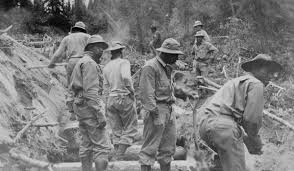During World War Two the US Army Corps of Engineers, fearing Japanese occupation of the Aleutian Islands, implemented an ambitious project building an oil pipeline linking high quality crude from Norman Wells to it’s junction with the Alaska Highway at Whitehorse, Yukon. The project began in 1942 and from the start, was fought with setbacks, battling inclement conditions in the rugged MacKenzie Mountains. After two years of construction, the first shipments of oil were delivered to the Yukon, but the flow did not last for long. With the war winding down in 1945, there was little incentive to continue maintaining the pipeline which was crippled by frequent failures due to more construction and variable permafrost conditions. Just 15 months after completion, the pipeline was shutdown and portions of the project’s infrastructure were shipped to Alberta. Even though the project has long ago come to an end, the Army Corp’s hasty departure left a legacy of environmental and cultural damage still visible on the landscape.
Fast forward 76 years from construction to present, 5 expeditious women, led by Dr. Sinead Earley, returned to the region for a very different reason from their male wartime counter parts. Traveling 600 km by bike, foot, and raft, they navigated the Canol Road, now something of a primitive trail, seeking to document the colonial afterlife of what had once been. At the same time, looking towards the future, these women now use their story to draw parallels between the now forgotten Canol project and questions about the trajectory of continued resource extraction in the North. Through their voices, photography, videography, and sheer athleticism they reframe human presence in the incredibly beautiful, yet delicate MacKenzie Mountains.
Dr. Earley is a scientist whose research intersects at crossroads of social geography, disturbance ecology, history and environmental science. Her approach to the CanolDoc Project captures the imagination of her audience because instead of simply relying on historical documents, photographs or second hand accounts, she and her team, positioned themselves in squarely in the raw elements of their study environment. From a place of having endured the physical rigors of the trail, the CanolDoc team not only documented the vivid contrasts between the region’s grandeur and environmental degradation, but also gained subtle subconscious information vital for understanding the perspectives of the labourers who build the pipeline and the spiritual significance of the land for First Nations bands in the region.
It is here, stories of the human tribulations emerge that illuminate the often harsh social dimensions of resource extraction and environmental degradation. The pipeline was constructed under the urgency of war before the advent of the civil or indigenous rights movements. Historical photographs of pipeline workers featured in Dr. Earley’s show the tired faces of African American soldiers worlds away from their homeland in the American south. Because black soldiers were not commonly sent to the front lines during World War Two, they were sent north to implement the arduous tasks of building the Canol Pipeline and the Alaska Highway. Dr. Earley had not yet explored accounts of African American experiences working in the north, but it is interesting to wonder if their assignment may have been both a blessing and a curse. Yes, they were away from the frontlines of battle but at the expense of racism and brutal work conditions.
Blessed by the First Nations bands who originally occupied the territories of the Mackenzie mountains, the CanolDoc Project showcases the vital role of indigenous communities in reclaiming the land. Dr. Earley spoke of the involvement of both elders and youth as a vital component remediation process. Though they had been originally been excluded at the conception of the pipeline, First Nation engagement in the cleanup represents a chance at reconciliation and renewal for original peoples as well as the land. Under their guidance, efforts are underway to restore the road into a safe and navigable trail that will allow visitors to re-engage and support this region in a sustainable, respectful way.


Recent Comments